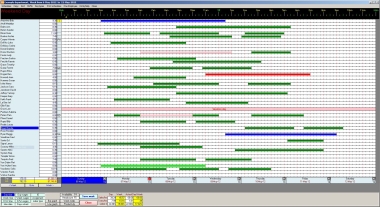

Shifts in trends happen all the time, and you want to be inline with it with your manpower planning. Analyze & AdjustĪfter you have mastered the perfect schedule for your business, make sure to revisit the data after a while. In fact, a research by HBR has found stable scheduling to increase sales and productivity. When your schedules are stable and there are no sudden changes all the time, this will improve the quality of life of your team and will in return show in their performance. The right way to create a schedule in the first place is to make sure your deliveries and regular events are already taken into account. By a need we mean an emergency or unexpected event, and not “because we realized there is a delivery tomorrow”. Once published, the schedule should not be changed unless there is a real need for that. The last thing any of us wants is to have their schedule changed the night before. Try to finalize and publish the schedule well in advance, so that your employees can plan their lives around it. Requests should be treated as an exception and not the norm. Then make sure, again, to be fair in fulfilling those requests, so that you don’t end up accommodating the requests for some people all the time and ignoring others all the time. The key to applying this, though, is to be clear in advance that requests will be taken into considerations but there is no guarantee to accommodate all of them. The best way to do this is to announce in advance that this is the deadline to submit requests and allow everyone to submit theirs. Try your best to accommodate your employees’s request every time you create a new schedule. Accomodate RequestsĮmployees have their own needs and it would be perfect to create a schedule that accommodates the needs of everyone. This will allow you to see previous weeks before setting this week’s schedule and help you be more fair. That’s why we recommend in the next section (see: Tips) to maintain one workbook with all weeks in one file. In fact, we can tell you from now, that it is impossible to give everyone a fair schedule in the same week. This is especially true when you are managing a large team. One of the most difficult tasks for a manager while creating the retail schedule is to make sure everyone is getting a fair treatment. If you have made sure to minimize overtime during normal times, you will have more than enough budget to use during peak times. So don’t be afraid to give your team the extra help when they need it the most. This lost revenue could be much more than what it saves from not utilizing the extra staff. In fact, from our experience, trying to save some money by not scheduling extra staff during these hours can actually lose the business money in the form of lost sales. Overtime or temp staff can be very important during peak times. Which emphasizes the need for proper scheduling that saves the overtime for when it is really needed.

Having said that, we know it is inevitable to require overtime at some occasions or under certain circumstance (example sudden absence of one employee). While creating your schedule and accommodating staff requests, make sure you are not giving unnecessary overtime, that will not be of any additional benefit to the business. Minimize OvertimeĪ good retail schedule is one that utilizes the available manpower perfectly, so that there would be no need for overtime. Keep track of this data for a while and establish a pattern, and then start aligning your scheduling with your sales and traffic trends. Many POS softwares will show you your sales by hour and your installed traffic counters to measure conversion rates will give you the traffic by hour as well. This means, more retail employees during high traffic and peak sales hours and days, and less employees when the traffic is low. The schedule should be created to provide maximum cover on the floor when it is really needed. Having said that, let’s dive into retail scheduling best practices. The ultimate goal is to create a balanced schedule that is aligned with the business needs, and at the same time accommodates retail staff needs as much as possible.


 0 kommentar(er)
0 kommentar(er)
